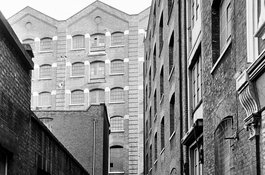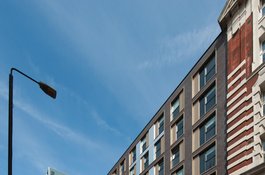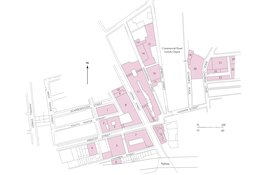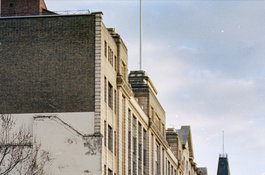Drapery Plaza (formerly Student Castle), 65 Leman Street
2011–13 student accommodation, replacing the Co-operative Wholesale Society's Drapery Warehouse of 1928–30 | Part of Co-operative Wholesale Society buildings
The wool warehouse (demolished) and later Drapery Warehouse extension at 53–65 Leman Street (demolished)
Contributed by Rebecca Preston on March 29, 2019
Early in 1925 the Co-operative Wholesale Society announced that it would shortly be acquiring the warehouse adjoining 75 Leman Street on its north side, the freehold of which it had owned since at least 1917, and into which it would expand after alterations to meet the needs of its growing drapery business.1 The large five-storey brown-brick wool warehouse with ten bays fronting Leman Street had been built in 1879 for Hyatt, Parker & Co. and from 1889 it was in use as a wool warehouse by C. H. Cousens & Co., to whom the CWS leased it in 1917.2 The front concealed a much larger range of warehouses behind, which reached north to Leman Passage and east to Goodman Street, and by its acquisition the CWS almost doubled the area of its property on the east side of Leman Street. The warehouse was demolished by 1928 when work began on the first portion of a new seven-storey steel-framed drapery warehouse designed by L. G. Ekins, which opened in February 1930.3 Although Ekins, as Chief Architect of the London Branch, was responsible for much of the new building on the CWS’s expanding Whitechapel estate between 1916 and 1939 his major and surviving architectural contribution lies on the west side of Leman Street and is covered further on. Nevertheless, the spare neo- classicism of his new drapery extension marked a departure from CWS architecture locally and was finished above the lower basement on its Leman Street front in moulded faience tiles and bronze panels to the floor sections,4 with narrow pilasters that broke up large areas of glazing to light the showrooms in the six-bay front. Inside, a cream marble entrance hall led to a Roman stone staircase and lifts to the ‘modern style’ showrooms above, where men’s and women’s wear made in CWS clothing factories was displayed in airy and glamorous surroundings for the retail buyers. It was said that the second floor ‘might have been mistaken for a conservatory, with its trellises of roses, bowls of gay tulips’ made from glass and ‘perfumed atmosphere’.5 The block eventually known as 65–99 Leman Street (i.e., including the headquarters building of 1887 and its 1910 extension) was initially addressed as 53–65 Leman Street and included large warehouses at 31–38 Rupert Street (later Goodman Street) adjoining the original CWS warehouses at its rear.6 At the opening of this extension in 1930 it was stated that development ‘marked the completion of about two thirds of the whole scheme of progress’ on the site.7 By that date additional warehouse space had already been acquired on the north side of Leman Passage fronting Goodman Street.8 In 1936 work was underway on this plot for the second phase of the drapery extension, which was completed by September 1937.9 The buildings formerly on the site numbered 53–63 included a printing works (Nos 53–55) built in the 1920s for Crane Bennett, heating engineers and sanitary specialists, which also had premises further up Leman Street, stables, and a run of shop houses with tenements above numbered 57–63, which abutted south on Leman Passage.10 In 1927 Stepney Borough Council had permitted the CWS to double the width of the passage, in order that the CWS might build over and under it according to plans presented. Ten feet of headroom was created in the covered sections with a central area open to the sky and the whole lit at the expense of the Society.11 By 1930 the CWS had acquired the printing works and the houses on the north side of the Passage, which were leased to tenants, including, by 1935, the Anchor Co-operative Society (which appears to have leased a series of buildings locally from the CWS) at No. 57.12 All were demolished for the final part of the drapery extension which, like previous extensions to 99 Leman Street, incorporated existing or new-built warehousing fronting Goodman Street at the rear. The overall building created an additional 45,000 square feet of floor space behind its 104ft-frontage, more than doubling that of the first phase, thereby ‘changing the skyline in Leman Street’.13 A sense of the presence of the CWS on the east side of Leman Street can be gleaned from the bird’s-eye photograph taken in 1949.14 This was the limit of CWS building on the east side of Leman Street itself. Expansion hereafter focussed upon Goodman Street and Lambeth Street to the east.
-
‘London Drapery’, The Producer, February 1925, p. 113; Whitechapel Land Tax records, 1917. ↩
-
OS map/VII.67/1875: Goad plan, 1887: London Metropolitan Archives (LMA), CLC/B/017/MS15627/040 and CLC/B/017/MS15627/052, Wharf and Warehouse Committee Plans, wool warehouses, Rupert Street & Leman Street, 1879 and 1889: illustration in The People’s Yearbook, 1926. ↩
-
‘The Loft that turned into a Palace’, The Wheatsheaf, April 1930, p. 55. ↩
-
Bridget Cherry, Simon Bradley, Charles O’Brien, Nikolaus Pevsner, London: East, 2005, p. 436. ↩
-
'The Loft that turned into a Palace’, The Wheatsheaf, April 1930, p.56. ↩
-
Tower Hamlets Local History Library and Archives (THLHLA), L/SMB/C/1/3, Metropolitan Borough of Stepney Valuation List, 1935, p. 109. ↩
-
Western Morning News, 26 February 1930, p.8. ↩
-
CWS London property plan, 1930, LMA, GLC/AR/BR/17/45017; Metropolitan Borough of Stepney Valuation List, 1935, THLHLA, L/SMB/C/1/3. ↩
-
‘Changing the Skyline at Leman Street, London’, The Producer, June 1936, p. 182; LMA, DSR serial no. 1937.1300-3; Historic England Archives (HEA), Britain from Above, EPW055309. ↩
-
Leman Street drainage plans, 1924, THLHLA, L/THL/D/2/30/88; photograph, 1929, of the premises of Crane–Bennett Heating Engineers, 45–51 Leman Street, with 1920 on the front of the building; 45–51 is also marked on the later 1920s’ building to its right, see CIBSE Heritage Group Photographs of Radiators, Stoves, etc., n.d., n.p.: http://www.hevac-heritage.org/; LMA, DSR serial no. 1924.0094–6; Metropolitan Borough of Stepney Valuation List, 1935, THLHLA, L/SMB/C/1/3. ↩
-
‘Stepney Borough Council’, East London Observer, 31 December 1927, p. 5. ↩
-
CWS property plan, 1930, approved 1932, LMA, GLC/AR/BR/17/45017; Metropolitan Borough of Stepney Valuation List, 1935, THLHLA, L/SMB/C/1/3. ↩
-
‘Changing the Skyline at Leman Street, London’, The Producer, June 1936, p. 182. ↩
-
HEA, Britain from Above: EAW021448, Leman Street and environs, Whitechapel, 1949,https://britainfromabove.org.uk/en/image/EAW021448. ↩
Social, political and cultural activity in the Co-operative Wholesale Society's premises in and around Leman Street
Contributed by Rebecca Preston on March 29, 2019
From its early days the Co-operative Wholesale Society organised social and educational activities for its staff and hosted meetings and other events, and later on leased property to co-operative and other organisations with whom it shared interests and values. At the suggestion of Mrs Benjamin Jones, wife of the London Branch manager, the first meeting of the Women’s Co-operative Guild took place at Hooper Square on 15 April 1886, attended by over seventy women and chaired by co-operative worker Catherine Webb.1 Representatives from Toynbee Hall had been present at the opening of the new headquarters building in 1887 and from at least 1885 the settlement had put on lectures for CWS workers at Hooper Square and also held classes for co-operators at Toynbee Hall.2 A library for employees was formed at the London Branch, not long after the fire had destroyed the premises in late 1885, when board meetings were transferred temporarily to Toynbee Hall.3 When Prof Sedley Taylor started a class in economics at Toynbee Hall, CWS staff were said to have formed the nucleus of his students.4 The Wholesale considered itself a beacon in the East End, its architectural presence drawing attention to its work in the promotion of co-operation, and provided office space for kindred organisations. Thus in the late 1880s and 1890s, 99 Leman Street was the address of the Co-operative Aid Association, the Tenant Co-operators Society, and the People’s Co-operative Society. No. 99 Leman Street also hosted public lectures on co-operative and related themes. A course of twenty university extension lectures was offered on the life and duties of the citizen on Saturday afternoons in 1893, held after the working week had finished at 4 o’clock on Saturdays in the Conference Hall. These were free to co-operators and 5s (or 2s 6d for the half course of ten) to the general public.5 In 1901, the Countess of Warwick presided at a conference at London Branch headquarters on London School Board Evening Continuation Classes.6
During the Co-operative Wholesale ‘tea girls’ strike’ over piecework at the tea department in 1904, Canon Barnett offered the women a room at Toynbee Hall while he opened negotiations between the CWS and the Women’s Trade Union League.7 In the 1930s, Toynbee Hall organised for parties of undergraduates and public school children to be taken around CWS premises locally.8 By the 1920s, in addition to the various departments and bank, 99 Leman Street was also home to the CWS Financial Propaganda Department, CWS Social Club, the Co- operative Press Agency and the Russo-British Co-operative Information Bureau.9 London Branch employees’ activities on site included a fine art club, with ‘notable exhibits of painting and sculpture from Leman Street’ being shown in the 1930s at the East End Academy in the Whitechapel Art Gallery.10 An Ethiopian Exhibition organised by Sylvia Pankhurst on behalf of the Princess Tsahai Memorial Hospital Fund, of which Pankhurst was the honorary secretary, was displayed during 1948 in the Boot and Shoe Showrooms at 99 Leman Street. Ancient Ethiopian traditional dress, embroidery, leather- work and illuminated books appeared alongside examples of modern textiles. This formed part of a project to form closer relations with ‘the brave Ethiopian people whose struggle against the aggression of Mussolini aroused sympathy and interest in this country’. A film, ‘This is Ethiopia’, was shown in the CWS film theatre at the Tea Office across the road in Prescot Street.11
-
Catherine Webb, The Woman with the Basket: The History of the Women’s Co-operative Guild, 1883–1927, 1927, p. 28. ↩
-
‘Opening of new Co-operative Premises in Whitechapel’, East London Advertiser, 5 November 1887, p. 7; Asa Briggs and Anne Macartney, Toynbee Hall: The First Hundred Years, 1984, p. 45. ↩
-
National Co-operative Archive (NCA), CWS Minutes, 29 February 1886. ↩
-
London Branch of the CWS, 1933, p. 30. ↩
-
Co-operative Union Southern Section, A Course of Twenty University Extension Lectures…, 1893, [p. 1]. ↩
-
‘Knowledge or Ignorance’, Sunday Times, 24 March 1901, p. 8. ↩
-
‘Co-operative Wholesale Girls’ Strike’, London Daily News, 12 October 1904, p. 8. ↩
-
Correspondence with the Co-operative Wholesale Society, Leman Street, re visit by Toynbee Hall students, November 1937, London Metropolitan Archives (LMA), A/TOY/015/002/047–048. ↩
-
Daily Herald, 1 January 1921, p. 6; CWS Annual, 1918, p. 289; People’s Yearbook, 1921, p. 377; The Producer, July 1925, p. 266. ↩
-
New History of the C.W.S., 1938, p. 506. ↩
-
‘Ethiopian Exhibition’, The British Journal of Nursing, July 1948, p. 85. ↩
The Co-operative Wholesale Society around Leman Street and its beginnings in London
Contributed by Rebecca Preston on March 29, 2019
The Co-operative Wholesale Society (CWS) opened its first warehouse in Whitechapel in 1881, on a plot on the north side of the present Hooper Street, just to the east of Leman Street. Very quickly, as CWS business expanded, the organisation bought up and built on neighbouring plots and by the 1930s this corner of Whitechapel was home to a series of impressive warehouses, offices, factories, showrooms and a bank, which flanked Leman Street and surrounding roads. Designed by CWS architects and engineers, many of the buildings in what became a Co-operative Wholesale colony have now gone and what remains has mostly been converted to apartments. Of the original warehouse built in 1879–1881, only the stair tower survives, a yellow-brick column to the rear of the CWS London Branch headquarters building at 99 Leman Street, which opened in 1887. That and some of its CWS successors still dominate the vicinity, not without a degree of architectural spectacle.
The Co-operative Wholesale Society – now The Co-operative Group – was founded in Manchester in 1863, to supply basic foodstuffs and daily necessities wholesale to Co-operative retailers. The wholesale society was a federal organisation, owned by the retail societies it traded with, and sought to integrate production and distribution in order to lower costs. As is well known, the co-operative principle of mutual benefit was established in 1844 by the Rochdale Equitable Pioneers’ Society, many of whose members had backgrounds in earlier co-operative, communitarian and socialist ventures.1 From around the mid-century, efforts were made to set up a central wholesale agency, culminating in what became the CWS.2 It began as the North of England Co-operative & Wholesale Industrial Society Ltd and expanded rapidly to serve the growing number of retail societies in England and Wales. When it became impossible to serve these from Manchester alone, subsidiary wholesale branches were set up in Newcastle-upon-Tyne in 1871 and in London in 1874. 3 London was considered difficult terrain, a ‘co-operative desert’ in need of irrigation and the story of the struggle to gain a foothold in the capital was characterised in 1913 as ‘the attack on London’.4
The CWS aimed to procure unadulterated goods at low prices, by ‘eliminating the middle-man and his profits’ rather than economising on labour.5 Beginning with butter, which accounted for a third of sales in the first decade, the CWS built a network of buyers, suppliers and, crucially, depots, which facilitated bulk purchasing and centralised processing in order to secure the best prices and quality.6 The co-operative principle of avoiding middlemen also underlay the Society’s policy in London of, wherever possible, purchasing the freeholds of its premises, ‘for co-operators, being prudent men, have a righteous horror of the short leasehold system’.7 Thus the CWS and a little later the English & Scottish Joint CWS (E&SCWS) became significant landowners in Whitechapel.
The first London Branch premises opened in 1874 at 118 Minories, a warehouse backing onto America Square on the eastern edge of the City of London. This was convenient for the docks and for markets, in particular Mincing Lane in the City, which was the centre of the international tea trade from the 1830s. The London Public Tea Auction, held in the London Commercial Sale Rooms at Mincing Lane, was established in 1834 after the dismantling of the East India Company monopoly.8 Tea fit with the temperance beliefs of many early co- operators and from the foundation of the Wholesale Society formed an important CWS commodity; it remained so as consumption of tea increased nationally, only levelling off in the 1940s.9 Within a few years of opening in London the business had outgrown the space available and the CWS began to look for larger premises. ‘Great difficulty was found in selecting a freehold site which would be at once convenient for the various markets and the railways’ but by the end of the 1870s a site in Whitechapel had been decided upon and in 1881 new London Branch premises were opened near Leman Street, less than half a mile east of the Minories.10 As the Society consistently pointed out to its members, Leman Street was both the highway to the docks and ‘conveniently adjacent’ to bonded tea warehouses.11 The premises were also keenly positioned within the railway network and bordered on the site of the future London, Tilbury & Southend Railway (Commercial Road) goods depot and its vast warehouses, which, when it opened in 1886, provided a link to the East & West India Dock Company’s new dock at Tilbury.12
-
Lynn Pearson, Architecture of the Co-operative Movement, draft Chapter 1: Laying the Foundations: Retail Societies, 1844–1890, 2018, p. 2. We are grateful to Lynn Pearson for help with this account. ↩
-
Pearson, Architecture of the Co-operative Movement, draft Chapter 2: Pioneering Production: CWS Depots and Factories, 1863–1897, p. 2. ↩
-
Anthony Webster, ‘Building the Wholesale: The Development of the English CWS and British Co-operative Business 1863–90’, Business History, 54(6), 2012, pp. 883–904, p. 894. ↩
-
Co-operative Wholesale Society Limited, London Branch, Opening of the New Premises and Cocoa Works, 1887, p.54; Percy Redfern, The Story of the C.W.S. The Jubilee History of the Co-operative Wholesale Society Limited, 1913, p.83; Webster, ‘Building the Wholesale’, p. 885. ↩
-
A. D. Harrison, ‘Review of The Story of the C.W.S. by Percy Redfern’, Charity Organisation Review, New Series, Vol. 35, No. 205 (January 1914), pp. 46–8, p. 46. ↩
-
Pearson, draft Chapter 2, p.1. ↩
-
Opening of the New Premises and Cocoa Works, p. 70. ↩
-
Markman Ellis, Richard Coulton and Matthew Mauger, Empire of Tea: The Asian Leaf that Conquered the World, 2015, p.249. ↩
-
Bishnupriya Gupta, ‘The History of the International Tea Market, 1850–1945’, EH.Net Encyclopedia, ed. Robert Whaples, 16 March 2008: https://eh.net/encyclopedia/the-history-of-the-international-tea- market-1850-1945/. ↩
-
Opening of the New Premises and Cocoa Works, 1887, p. 9 ↩
-
‘CWS: Tea Growers, Blenders, and Packers II’, The Wheatsheaf, February 1908, p. 120. ↩
-
Tim Smith,‘Commercial Road Goods Depot, Whitechapel’, Greater London Industrial Archaeology Society, 1979,re-typed with annotations, January 2000: http://www.glias.org.uk/journals/2-a.html. ↩

View along the eastern section of Leman Passage in the early 1970s looking east (photograph by Dan Cruickshank)
Contributed by Dan Cruickshank

65 Leman Street from the southwest in 2017
Contributed by Derek Kendall

The Co-operative Wholesale Society estate in 1968
Contributed by Helen Jones

65–99 Leman Street from the north in the late 1990s, photo by Chris Redgrave
Contributed by Chris Redgrave